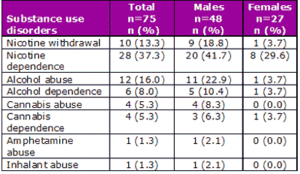Many researchers have looked at how substance abuse and pathological gambling correlate (e.g., Cunningham-Williams, Cottler, Compton, Spitznagel, & Ben-Abdallah, 2000; Feigelman, Wallisch, & Lesieur, 1998; Lesieur, Blume, & Zoppa, 1986; Shaffer, in press; Welte, Barnes, Wieczorek, Tidwell, & Parker, 2001). Because researchers frequently use different tools and methods to study this relationship it makes it difficult to compare the results. This week The WAGER examines a study by Maccallum and Blaszcynski which reports the first Composite International Diagnostic Interview (CIDI) data relating pathological gambling and substance abuse.
Maccallum and Blaszcynski recruited seventy-five (48 male) gamblers seeking treatment for disordered poker machine use. All of the gamblers met the DSM-IV criteria for pathological gambling. This study took place at an impulse control research clinic in Sydney, Australia which specifically specialized in the treatment of problem gamblers. The subjects took the South Oaks Gambling Screen (SOGS; Lesieur & Blume, 1987) and a semi structured clinical interview to see what individuals said about their own habits. The individuals that were pathological gamblers were included in the final sample and were asked to complete the CIDI auto v2.1, 12 month version (World Health Organization, 1997). This instrument determined whether or not there was evidence of mental illness in the past twelve months.
Table 1. Rate of DSM-IV Substance Use Disorders (Maccallum & Blaszczynski, 2002)
According to the information collected from the CIDI the substances most commonly used were nicotine and alcohol (see Table 1). Specifically, 37.3% of all participants reported nicotine dependence and 16% of participants reported alcohol abuse. The data indicated that other substance use disorders were not as common. Nine people out of the sample did not have any substance use disorder. In evaluating the report it was discovered that males (22.92%) were more likely than females to have an alcohol abuse disorder (3.7%; Fisher’s Exact p<0.03).
This study has some limitations. There were only 75 participants, which is not a large number and 48 of these were males—almost twice the number of females. It is possible that males were over represented in this study. There was no information collected on the ethnic or economic status of the participants. These two factors could affect the substance use and gambling of the study participants. This particular study was limited to gamblers with poker machine disorders, making a wide scale generalization difficult. Furthermore, the participants were all seeking help: their results might not be representative of those who gamble problematically but are not yet seeking help. All of these things limit our ability to generalize beyond this study.
This was the first study to use the CIDI to look at the relationship between the pathological gambler and people with substance use disorders. This information would be helpful for substance abuse specialists and doctors to know, and it would also be helpful for people with other disorders to recognize the association between substance abuse and gambling. The information presented in this report depicts the connection between the use of substances and the pathological urge to gamble and vice versa.
Comments on this article can be addressed to Lynda Bolt or Tony Donato.
References
Cunningham-Williams, R. M., Cottler, L. B., Compton, W. M., Spitznagel, E. L., & Ben-Abdallah, A. (2000). Problem gambling and comorbid psychiatric and substance use disorders among drug users recruited from drug treatment and community settings. Journal of Gambling Studies, 16(4), 347-376.
Feigelman, W., Wallisch, L. S., & Lesieur, H. R. (1998). Problem gamblers, problem substance users, and dual problem individuals: an epidemiological study. American Journal of Public Health, 88(3), 467-470.
Lesieur, H. R., Blume, S. B., & Zoppa, R. M. (1986). Alcoholism, drug abuse, and gambling. Alcoholism: Clinical & Experimental Research, 10(1), 33-38.
Maccallum, F., & Blaszczynski, A. (2002). Pathological gambling and comorbid substance use. Australian and New Zealand Journal of Psychiatry, 36, 411-415.
Shaffer, H. J. (in press). A critical view of pathological gambling and addiction: comorbidity makes for syndromes and other strange bedfellows. In G. Reith (Ed.), For Fun or Profit? The Controversies of the Expansion of Commercial Gambling. New York: Prometheus Books.
Welte, J., Barnes, G., Wieczorek, W., Tidwell, M.-C., & Parker, J. (2001). Alcohol and gambling pathology among U.S. adults: prevalence, demographic patterns and comorbidity. Journal of Studies on Alcohol, 62, 706712.
World Health Organization. (1997). Composite international diagnostic interview – auto 2.1. Geneva: WHO.





